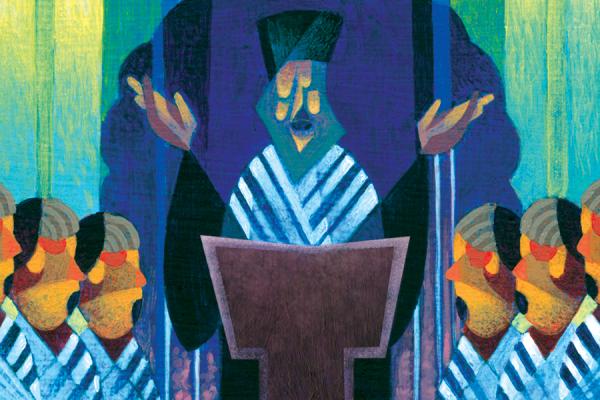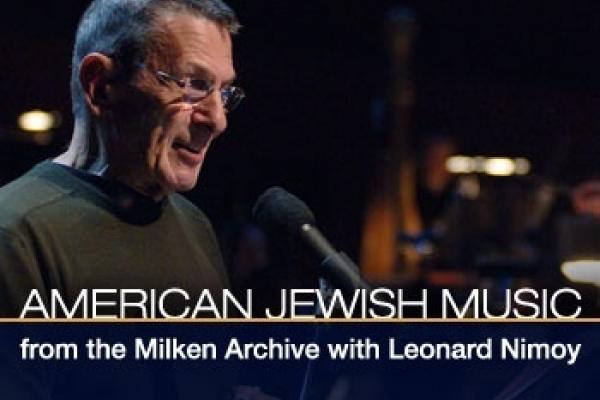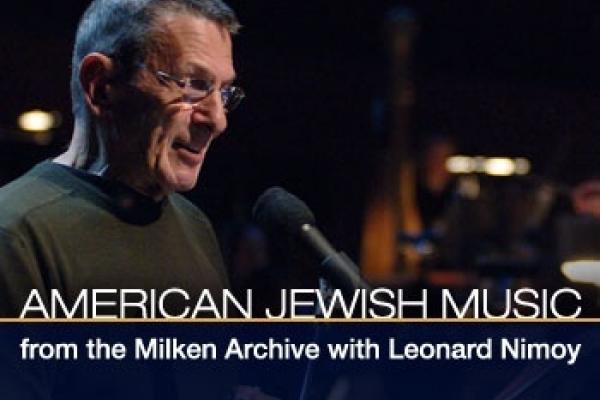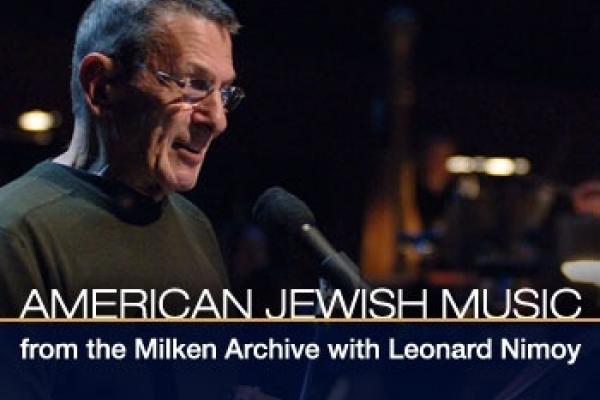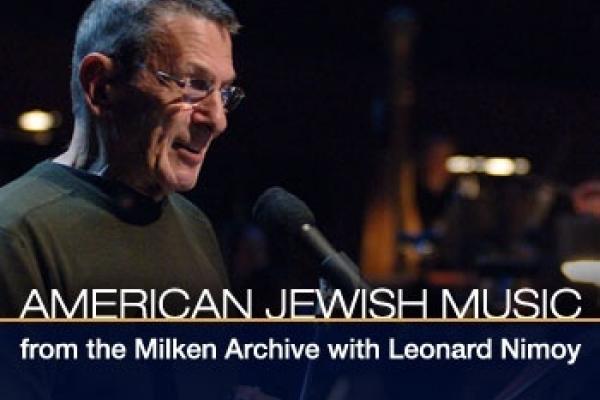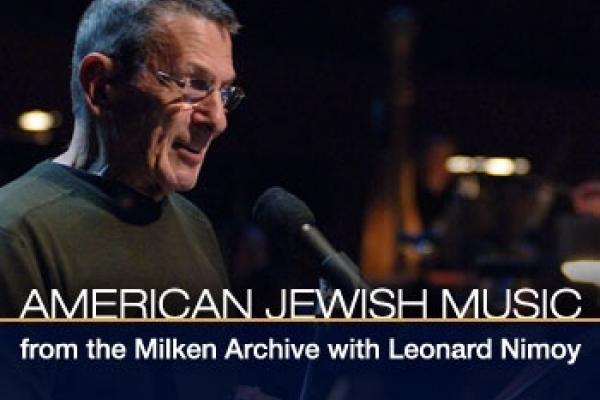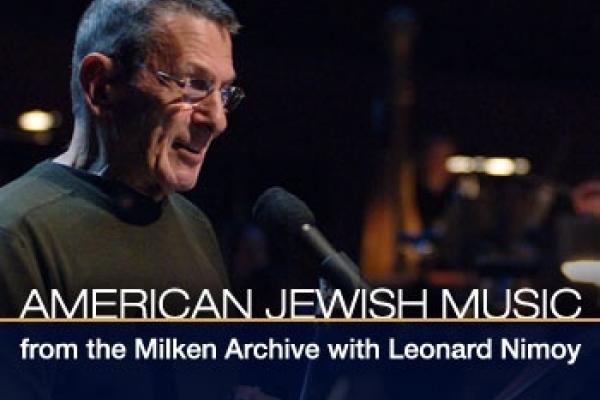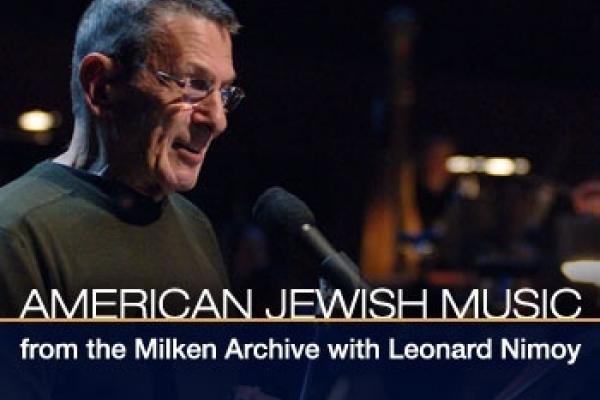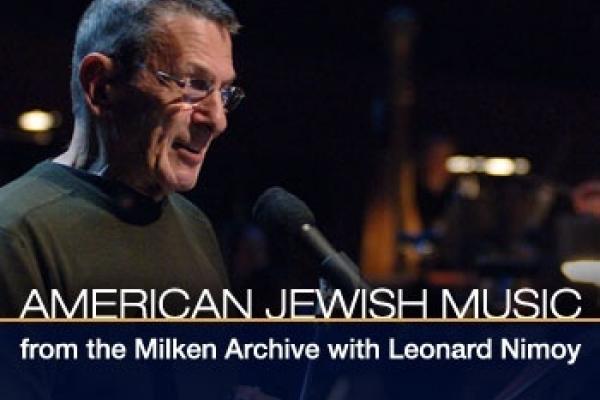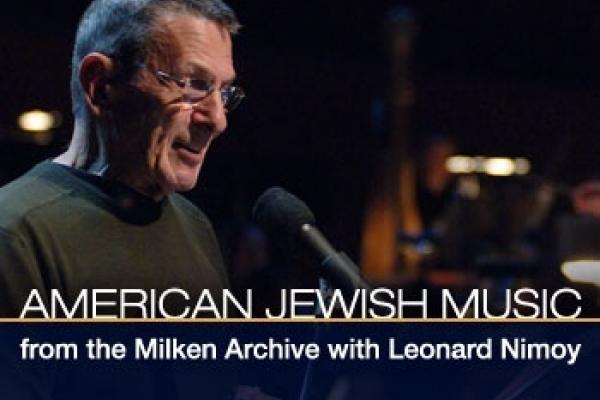Episode 9: Sephardi Influence
Click on the ![]() icon on the top-right of the video to access the full playlist.
icon on the top-right of the video to access the full playlist.
Episode 9 highlights music directly from or inspired by the Jewish experience on the Iberian Peninsula, including the first Jewish music sung or heard in North America, and classical compositions based on Sephardi musical traditions and historical events.
Episode Transcript
Leonard Nimoy
In the year 711, the Moors drove out the Visigoths and occupied Spain, inaugurating an era of civilization and religious toleration. Especially in the 9th, 10th, and 11th centuries, the Jews of the Iberian Peninsula – living under Muslim rule -- displayed extraordinary creativity in philosophy and literature, especially poetry. This period ended with the expulsion of the Jews in 1492 from Spain by the Roman Catholic monarchs Ferdinand and Isabella, and a few years later from Portugal. To this day it is known as the “Golden Age of Spanish Jewry.”
Leonard Nimoy
Hello, I’m Leonard Nimoy. Welcome to another program in a 13-part series that celebrates three and a half centuries of uninterrupted Jewish life in the United States through music, as documented by the Milken Archive of American Jewish Music, and issued on CD on the Naxos label. On today’s program: music inspired by the culture of the Jews with ancestral roots on the Iberian Peninsula – the “Sephardim.”
Leonard Nimoy
Neil Levin, the Artistic Director of the Milken Archive, tells the story of the Iberian Jews after the Expulsion, in conversation with conductor Gerard Schwarz.
Neil Levin
The majority of the Jews who accepted the expulsion, by which I mean to say did not accept conversion, went back to Muslim ruled lands because they had flourished in the golden age of Spanish Jewry under Muslim rule, places such as North Africa, Mediterranean areas, Turkey, Greece, so forth. A smaller number about a hundred years later, who had converted to Christianity and remained in Spain, decided that they wanted to retake their Jewish roots. They went to Amsterdam, and then from there to a few other European cities. But Amsterdam was kind of the capital of what became the Western Sephardi tradition. Those are the Jews who came to the United States in 1654 from an earlier Dutch area in Brazil and established the first American Jewish community and the first American synagogue. Those were Western Sephardic. And by the American Revolution, there were about 5,000 Jews, mostly not all, but mostly of the Western Sephardi tradition, which by that time was Amsterdam - London.
Gerard Schwarz
On a musical level now, the Sephardi has influenced composers in some ways more yet than the Ashkenazi because of the basic rhythmic, folk-like, exciting elements that this music represents.
Neil Levin
I think a lot of that is the interest in the other, it's the interest in the exotic.
Gerard Schwarz
It seems to me that so much of what we do in traditional Jewish music is vocal and of course, deals with a lot with language. So now what about the special Sephardi language? What about Ladino? How does it relate to how it's sung, what we understand to Spanish, to Hebrew? What's the relationship?
Neil Levin
Ladino, which is also known as Judeo Espanol, is a mixture of Castilian Spanish, 15th century Spanish, not modern Spanish, and Hebrew primarily. And it was the kind of vernacular, the daily spoken language of Sephardi Jewry in the Mediterranean areas. The daily spoken language of Greek Jews up through the 20th century was, at least in part, Ladino, or Judeo Espanol. It's a secular language. It's analogous in many ways to Yiddish for Ashkenazi Jewry. Yiddish is a mixture of 12th century German and Hebrew, plus some other Slavic languages. Ladino, the interest in it, in music is astounding in a way, and understandable in another way, because it's this fascination with something that we didn't know about until recently, and it was always there, and that's fascinating in itself. And there is a very rich literature of Ladino poetry, folk poetry and songs.
Leonard Nimoy
Music historian and musicologist Neil Levin, talking with Gerard Schwarz. Let’s listen now to what may well be the first Hebrew liturgical setting ever created on American soil. It’s a melody for three verses from Psalm 118: “Barukh Habbá” – “Blessèd be he who comes in the name of the Lord.” The tune was brought to the New World by the Sephardim in the 17th century, from their Amsterdam repertoire. This particular arrangement for these psalm verses was put together expressly for the consecration ceremony of Congregation Mikve Israel in 1782 in Philadelphia, during the Revolutionary War. It was sung during the procession, completely in unison, just as we hear it in this Milken Archive recording.
Leonard Nimoy
The soloist here is Hazzán Ira Rohde, presently the cantor of the Spanish and Portuguese Synagogue in New York, Shearith Israel – America’s first synagogue, dating to 1654. Neil Levin conducts the Schola Hebraeica in “Barukh Habbá,” from Psalm 118.
Works from Amsterdam|Western Sephardi Tradition
Leonard Nimoy
Two liturgical elegies, or “kinot,” for the day of communal mourning called “Tish’a b’Av.” That day commemorates both the destruction of the ancient Temples in Jerusalem, and also the expulsion of the Jews from Spain in 1492. These tunes from the repertoire of Colonial American Jewry, and its Sephardi tradition, are representative of the first Jewish music in America. We opened with a setting of part of Psalm 118. Hazzán Ira Rohde was soloist with the Schola Hebraeica under the direction of Neil Levin, performances taken from a Naxos CD. On today’s program we’re listening to music from the Sephardi tradition, from the Milken Archive of American Jewish Music.
Leonard Nimoy
From Colonial America we move to the twentieth century, and a concert piece by Marvin David Levy. Gerard Schwarz spoke with Neil Levin about the Marranos, the “secret Jews” who are the subject of Levy’s work.
Gerard Schwarz
It seems to me that composers take one of two directions. One is to realize a traditional Sephardi song or poem, and the other is to come up with something very original and something that is very much their own in some way referring through language or through the story of the Sephardi tradition and history. Could you talk about one of the pieces that use the Ladino language that is really very traditional?
Gerard Schwarz
It seems to me that composers take one of two directions. One is to realize a traditional Sephardi song or poem, and the other is to come up with something very original and something that is very much their own in some way referring through language or through the story of the Sephardi tradition and history. Could you talk about one of the pieces that use the Ladino language that is really very traditional?
Neil Levin
Marvin David Levy's work, Canto de los Marranos, is a piece for soprano and symphony orchestra, and this piece uses Hebrew and Ladino and English.
Gerard Schwarz
This work tells the story of the 70,000 Jews that were killed in 1391. It talks about the expulsion. Actually, it begins with a statement about the history of the Sephardi Jews in Spain.
Neil Levin
Yeah, it opens actually with a quotation from the expulsion decree of Queen Isabella and King Ferdinand. This piece talks about the Marranos. Marranos, literally, the word means swine. It was the epithet attached to Jews who had converted to Christianity out of pressure, but who secretly nurtured some tie to Judaism, whether it was in some small ritual way, lighting candles on the Sabbath, secretly in the basement, or some emotional tie which after a while became almost meaningless because they couldn't pass on why they were doing what they were doing to their children. But they kept some of these rituals. And there are, generations later, there were people who had some of these Judaic practices in their family customs, but didn't know why, didn't know that. It's because they were Jews at one time and didn't want anyone to know that they were. But Marvin told me that he was trying to capture the feeling of ambivalence, of more than ambivalence, of real reluctance to admit to the conversion and to recite those words that they didn't really want to recite. I mean, I'm quoting now, the composer, he talked to us right after the recording session.
Neil Levin
I think he said something to the effect that there was always that rage right beneath the surface of these people.
Gerard Schwarz
Why do you think he wrote? I mean, here's a composer born in New Jersey in 1932. Why would he write in Hebrew, Ladino, and English? Why wouldn't he just write the piece in English?
Neil Levin
Well, I can't speak for him, but I think its effectiveness is increased and enlarged very much by the juxtaposition of languages when you hear the actual recitation in the original language. I know, Marvin, and I know that he has a tremendous dramatic sense. I mean, he is essentially an opera composer. So I would imagine that that was the instinct, that that's what excited him.
Leonard Nimoy
Marvin David Levy’s “Cantos de Las Marranos” is performed here in a Naxos recording made for the Milken Archive by the Barcelona Symphony/National Orchestra of Catalonia conducted by Jorge Mester. The soprano soloist is Ana Maria Martinez.
Marvin Levy's Cantos de Las Marranos
Leonard Nimoy
A work by Marvin David Levy called “Cantos de Las Marranos” – songs of the secret Jews – performed on a Naxos CD by soprano Ana Maria Martinez with the Barcelona Symphony/National Orchestra of Catalonia, Jorge Mester conducting. On today’s program from the Milken Archive we’re featuring music inspired by the Jews who trace their origin to the Iberian Peninsula – the Sephardim. I’m Leonard Nimoy.
Leonard Nimoy
Here again is Gerard Schwarz, a member of the Editorial Board of the Milken Archive, speaking with the Milken Archive’s Artistic Director, Neil Levin.
Gerard Schwarz
Sam Adler is an extraordinary composer with tremendous harmonic gifts, melodic gifts, and a tremendous understanding of traditional Jewish music. Why would Sam, who really does not have a relationship now to Sephardi, why would he, do you think, embrace this tradition?
Neil Levin
Because we're in America. Because in America, all these things mix. Sam Adler came from Mannheim. His father was an important cantor in Mannheim, and after Kristalnacht, they knew instinctively that it was time to leave, that it wasn't going to blow over. But his roots are very much German Jewry.
Neil Levin
So had the Adler family never emigrated to the United States, I suspect he never would have taken any interest in Sephardi music. I think this is very much a part of the openness and curiosity that is American, and I think Sam would say the same thing.
Neil Levin
By the time he wrote these pieces, it was very much part of American Jewish culture to be interested in all of the other Jewish communities throughout the world. And again, I emphasize this is very much a part of the connection with the state of Israel and American Jewry.
Leonard Nimoy
Here are three Sephardi Choruses in settings by Samuel Adler.
Samuel Adler's Five Sephardic Choruses (excerpts)
Leonard Nimoy
Three of the “Five Sephardic Choruses” by Samuel Adler, sung in Hebrew by Mary Ellen Callahan, Ted Christopher, Heather Johnson, Matthew Kirchner, Gideon Dabi, Helen Kruczewski, and the Rutgers Kirkpatrick Choir conducted by Patrick Gardner. The pianist was Pen Ying Fang in this Naxos release from the Milken Archive.
Leonard Nimoy
Another contemporary American composer has created settings of Sephardi origin in the Ladino language, as Gerard Schwarz remarked to Neil Levin.
Gerard Schwarz
Bruce Adolphe took these extraordinary ladino songs and he realized them in a very unusual way with the soprano, a horn and a guitar. And yet when you listen to them, it almost feels like you're hearing a shofar, an organ and a singer, even though it's a horn, a guitar. I mean, it's absolutely, I think, brilliant in the way that he realized these, again, exquisite songs in a very untraditional way. As Sam Adler did it in a very traditional way.
Neil Levin
The original natural habitat sound of Ladino songs would be a cappella. So Bruce Adolphe is trying to do something artistic. He's not being an ethnomusicologist here. He's being a composer utilizing something from folk literature. And I think you're right. I think he succeeds beautifully. The guitar, no, it's not literally part of that sound, but it relates to it in a way because of the Spanish and flamenco guitar and so forth. And the horn has a purity of sound which it's interesting. Some composers have said to me they thought such and such. The instrument was most like the shofar and some others and so forth. But it creates a balance between natural habitat and artistic license.
Leonard Nimoy
Neil Levin, in a conversation recorded for this radio series with conductor Gerard Schwarz.
Leonard Nimoy
Here are Four Ladino Songs by Bruce Adolphe, with soprano Lucy Shelton accompanied by guitarist Eliot Fisk and David Jolley, horn.
Bruce Adolphe's Ladino Songs of Love and Suffering (excerpts)
Leonard Nimoy
Lucy Shelton, soprano, performed those four Ladino Songs by the American composer Bruce Adolphe, with Eliot Fisk, guitar, and David Jolley, horn, from a Naxos release.
Leonard Nimoy
The composer and pianist Simon Sargon has been based in Dallas for many years. He has created a number of large-scale works including a symphony about the Holocaust, and an oratorio called “Psalms of Qumran.” Here is an example of his more intimate music: traditional Sephardi songs also in the Ladino language, arranged for voice and piano in a set called “At Grandfather’s Knee.” Ana Maria Martinez sings five of them, accompanied by pianist Kristen Okerlund.
Simon Sargon's At Grandfather's Knee
Leonard Nimoy
Welcome back to this program from the Milken Archive of American Jewish Music. I’m Leonard Nimoy. Today we’re listening to music drawn from, and inspired by, the culture of the Sephardim – the Jews who trace their origins to Spain or Portugal.
Leonard Nimoy
Earlier on today’s program we heard Sephardi choruses by Samuel Adler. Lowell Milken, founder of the Milken Archive, recalls how the premiere performance of another work of Adler’s held special meaning for him.
Lowell Milken
Another piece that was very memorable to me is a piece that Sam Adler wrote, an original composition called the "Challenge of the Muse." And he wrote this piece to celebrate the indomitable spirit and the courage of the earliest Jewish settlers in New Amsterdam and of their survivors of the Holocaust, and how they were able to build a new life out of the suffering and adversity. And what was particularly touching to me is that Sam dedicated this original composition to me for the work of the Archive. And we had the world premiere of it during our conference in New York in November 2003. That was a very memorable event also.
Leonard Nimoy
The founder of the Milken Archive, Lowell Milken.
Leonard Nimoy
One of the most beloved prayers in the Jewish liturgy is a poem that welcomes the Sabbath on Friday just before sunset. It is called, in Hebrew, “L’khá Dodí,” and it greets the Sabbath as if it were a bride at a wedding. We’ll open this half of our program with a lively setting of this 15th-century Kabbalistic text by a cantor from the Moroccan Sephardi tradition.
Gerard Schwarz
Aaron Bensoussan was a cantor, or is a cantor, and wrote this extraordinary work, which is more of what we think of when we think of Sephardi music. It has improvisatory beginning. It has a dance feeling, and has a relationship between the cantor and the chorus that grows. And it doesn't sound like it's composed the way Marvin David Levy's work is, or Bruce Adolphe's work.
Neil Levin
Your instincts are right on the mark there. It's a mixture of improvisation and a fixed tune. I mean, it gets into the whole business of what "compose" means. It really comes out of the Latin, which just means to put together. Bensoussan is employing an Eastern Mediterranean Sephardi virtuoso tradition in the strophes of this text. And for the refrain, he created an entirely original melody. This is, again, what we've talked about many times in terms of cantorial art on the Ashkenazi side. Now we're talking about it on the Sephardi side. It's an improvisatory art. It's cantor - composer, creating for himself and creating improvisatorially. Now there are more tunes, more separate tunes for L'kha dodi than any other text in the entire liturgy. We are not talking about hundreds. We are talking about, at the very minimum, many, many thousands. So this adds one more. But it's a wonderful illustration of the sephardi tradition in its Eastern Mediterranean guise.
Leonard Nimoy
Here is Cantor Aaron Bensoussan’s setting of the pre-Friday-evening prayer “L’chá Dodí,” in a performance from a Naxos CD by the composer, with the New London Children’s Choir and Schola Hebraeica under the direction of Neil Levin.
Leonard Nimoy
Cantor Aaron Bensoussan performing his own setting of the beloved prayer for welcoming the Sabbath entitled – in Hebrew – “L’khá Dodí.” He was joined by the Schola Hebraeica and the New London Children’s Choir led by Neil Levin.
Leonard Nimoy
That last piece is based on the metaphor of welcoming the Sabbath as if a bride is joining her beloved. The text of the next work is intended for mothers to instruct their daughters about weddings and marriage. Here again are Gerard Schwarz and Neil Levin.
Gerard Schwarz
The other composer who, like Hugo Weisgall, is a great intellectual and knowledgeable individual. Not only to deal with music, to deal with Jewish subjects, is Samuel Adler. We've already heard some of his Sephardic choruses. Now he has written a work that we're about to hear based on a very different side of Sephardi. In fact, not even the correct language of the Sephardi.
Neil Levin
Yeah, this piece is sui generis in Adler's own catalog. It's one of my favorite pieces of all his works. It's musically free, it's musically original. It's not necessarily based on any traditional motifs, but its text is based on poetry that was originally in the Catalan language. Not Spanish, but Catalan, the language spoken in Catalonia, in the area around Barcelona today. And poetry relating to the prenuptial rites and in particular the kind of anticipation with some concern involved, shall we say, on the part of the young bride.
Leonard Nimoy
This composition, by Samuel Adler, was premiered in 1976 in Jerusalem. It’s performed here in a Milken Archive recording released on Naxos by Margaret Bishop-Kohler, mezzo-soprano, with the Eastman Players under the composer’s direction. Here is “Prenuptial Scene,” by Samuel Adler.
Leonard Nimoy
“Prenuptial Scene,” by Samuel Adler. In a Naxos release, mezzo-soprano Margaret Bishop-Kohler sang with the Eastman Players, directed by the composer.
Leonard Nimoy
This program of works from the Sephardi tradition is part of a series from the Milken Archive of American Jewish Music. I’m Leonard Nimoy. The Russian-born composer Lazar Saminsky – one of the founders of the St. Petersburg Society for Jewish Folk Music – was drawn to the East, and in 1913 he went to the Caucasus to research its ancient Jewish music traditions. He was also interested in the history of Sephardi Jewry, and he composed an opera-ballet, or choreo-drama, in Hebrew, titled “A Vision of Ariel.” It concerns Marranos, Jews who had converted to Christianity under pressure of the Spanish Inquisition, but who secretly continued some Jewish practices.
Leonard Nimoy
The first scene takes place in Spanish-ruled Flanders, where Ariel and a group of Jews are gathered on the holiday of Purim. They have come together for the chanting of the Book of Esther, which tells how the Jews of ancient Persia were saved from annihilation.
Leonard Nimoy
In the third scene, a group of Jewish martyrs is heard singing as a chorus the heart-wrenching memorial prayer for ancient martyrs, “Av Harachamim.” “Father of mercies,” they sing, “in Your mighty compassion, remember the loving, righteous, and blameless ones who laid down their lives for the sanctification of Your Divine Name.” Ariel echoes those words inside, as he fights the invading soldiers to his own death.
Leonard Nimoy
Here are those two scenes, performed in a Naxos release by tenor Alberto Mizrahi with the Barcelona Symphony/National Orchestra of Catalonia and the Choral Carmina conducted by Jorge Mester.
Lazare Saminsky's The Vision of Ariel
Leonard Nimoy
Jorge Mester led the Barcelona Symphony/National Orchestra of Catalonia and the Choral Carmina, with tenor Alberto Mizrahi, in two scenes from “A Vision of Ariel,” by Lazar Saminsky, from a Naxos CD. It's the final selection in our program of music deriving from the Sephardi culture and traditions.
Leonard Nimoy
You’ve been listening to another program in a 13-part series devoted to the recordings of the Milken Archive of American Jewish Music, currently being issued on CD by the Naxos label. The Milken Archive was created by Lowell Milken, chairman of the Milken Family Foundation. Neil W. Levin is Artistic Director.
Featured Speakers
 Lowell Milken |  Neil Levin |  Gerard Schwarz |
|---|
Featured Tracks
| Amsterdam|Western Sephardi Tradition: Barukh habba; Aleikhem eda k'dosha, Ev'ke v'al shod z'vulai |
| Marvin David Levy: Canto de los Marranos |
| Samuel Adler: Five Sephardic Choruses (excerpts) |
| Bruce Adolphe: Ladino Songs of Love and Suffering (excerpts) |
| Simon Sargon: At Grandfather's Knee |
| Aaron Bensoussan: L'kha dodi |
| Samuel Adler: Nuptial Scene |
| Lazare Saminsky: A Vision of Ariel |
About the Series
| Produced in conjunction with the WFMT network and broadcast on radio stations throughout the U.S., American Jewish Music from the Milken Archive with Leonard Nimoy is a 13-part series of two-hour programs featuring highlights from the Milken Archive’s extensive collection of the musical recordings. Episodes include interviews and commentary with Lowell Milken, Neil W. Levin, and Gerard Schwarz. Radio stations interested in broadcasting the series should contact media@milkenarchive.org. |
Date: January 17, 2024
Credit: Milken Family Foundation
